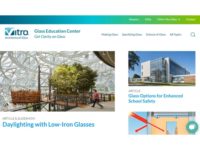Vitro Architectural Glass Updates Glass Education Center Website

Vitro Architectural Glass (formerly PPG Glass) announced that it has updated its online Glass Education Center website with a series of three new articles that address trending topics relating to sustainability, including a comprehensive review of embodied carbon, a discussion of biophilia and biophilic design and a review of green building codes and code organizations.
“What is Embodied Carbon?” explains what architects and glaziers need to know about embodied carbon as it relates to architectural glass products and production, as well as what steps manufacturers can take to reduce embodied carbon and how to evaluate and utilize Environmental Product Declarations (EPDs).
In “Biophilia and Glass: Supporting a Connection to Nature,” readers can learn more about biophilia, a concept that suggests human beings have a natural desire to be connected to and immersed in nature. The growing practice of biophilic design in architecture is all about maintaining a connection to nature and light through a building, with glass being the most popular transparent building material used in contemporary architecture and building construction.
“Codes and Climate Zones” reviews green building strategies that can help reduce energy consumption and that are increasingly being introduced to traditional building codes, including the two major building codes established in the U.S. that impact the glass industry: the International Energy Conservation Code® (IECC) and the American Society of Heating, Refrigeration & Air Conditioning code (ASHRAE).
“Thanks to feedback from our Glass Education Center users, we’ve found there is a significant demand for educational content about topics relating to designing and building with glass,” said Rob Struble, director of brand and innovation, Vitro Architectural Glass. “With the focus on sustainability across the entire industry, we’re pleased to provide these new articles that will help architects, designers, fabricators and others better understand the issues facing them today.”
Since its creation in 2013, the Vitro Glass Education Center has published more than 60 posts that use a combination of videos, infographics, slide shows and narrative articles to examine a wide variety of glass industry topics. Its library of content is continually expanding, with new topics added regularly based on the questions Vitro Glass sales representatives and call center personnel receive.
Last year, the Vitro Glass Education Center underwent a significant update that included the introduction of a restructured homepage, re-organized content categories and an updated article tagging system that makes it even easier to browse Vitro’s vast library of educational content on the science of glass. The update also improved the overall functionality of the site, with specific improvements being made to the navigation, homepage and search tool.
Additional highlights of the updated glassed.vitroglazings.com are functionality improvements that make the site more mobile-friendly.
To learn more about the Vitro Glass Education Center and browse its library of educational content, visit glassed.vitroglazings.com.
Looking for a reprint of this article?
From high-res PDFs to custom plaques, order your copy today!





